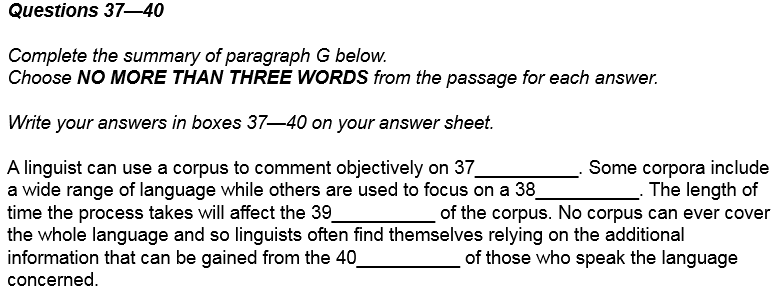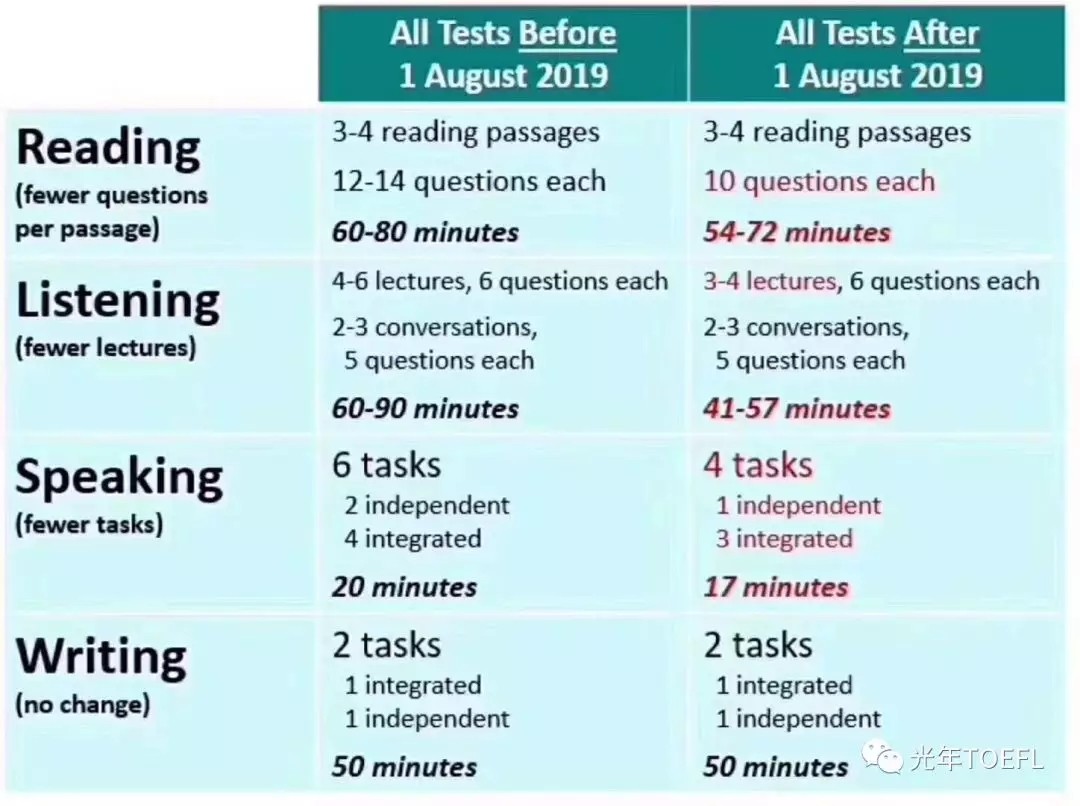在雅思的四科里,阅读是重中之重,如果阅读不上7,那么分数很可能只能在6分线上徘徊。下面小编给大家带来了雅思阅读目标7分的你所必须掌握的解题基本技能,希望能够帮助到大家,下面小编就和大家分享,来欣赏一下吧。
雅思阅读目标7分的你所必须掌握的解题基本技能
划关键词:我们需要彻底理解每道题的题干部分,划出重点词汇,理解这些词汇会有助于我们去理解题目和文章。我们以下面这道例题举例:C9T1S1

当我们拿到这道题的时候,我们很容易发现这道题里有很多大写字母,拿第一题举例,这里有两个人,一个MF一个P,那我们选取这两个人做定位,可是往下看被吓到,7题里面有6题提到了P这个人,说明这个人在文章中必然很多,我们再瞄一眼文章标题,发现就是这个人的全名,那么很简单,这是一篇人物传记,讲解的就是这个发明合成染料的人的简介。这道题目告诉我们,当题目中有人名、地名或者专有名词时我们应该优先选取作为我们的定位词,因为这些词汇比较明显,容易被识别,但是注意如果这个词分布全文,那么就意味着这是一个主题词,不可用。
同义替换:有时我们选取了定位词,但是这个词却并没有以原词的方式出现在文章当中,而是在一定程度上做了变形,那么此时我们需要注意我们划取的关键词做了同义替换。
我们还以刚刚那篇文章中的第4题举例,我们划取关键词为rich and famous,在原文中我们发现了fame and fortune,显然是这两个形容词的同义替换。
同学们请一定注意,这两项基本技巧贯穿雅思阅读,随着题型和文章布局的变化也会有相对应的小技巧,所以请大家一定重视起来。同时我们也看出,如果题目只是这种细节型题目,我们完全可以使用这两项基本技巧快速得到答案,而不需要去花费太多时间去吃透全文。
以下我们将选取雅思阅读几大常见题型来细解每种题型的技巧:
填空题:填空所占的比例可谓相当大,想要拿到7分的学员,填空题可谓兵家必争之地,分毫不可失。但是奈何填空题变形多种多样,那我们如何从纷繁的填空题型当中找到一些共性呢?首先,所有的空都可以确定其词性和单复数,这一部分的判定只需要初高中的基本英语语法即可成功判断,但是在判断过程中一定要小心仔细,避免由于句型稍复杂的情况下把主语藏得比较远,导致学员判断失误。
我们以14题举例,有些学员可能并没有太过关注这里的细节,会直接以为problems是主语,但是显然此处的问题(们)是复数与is主谓不一致,我们继续向前寻找就会发现真正的主语是proportion。
其次,我们需要理解语境和上下文,对空处所填写的单词做出合理的判断,我们任然拿14题举例,主语是proportion(比例),这个词与is连用形成主系表结构,那么这里要不然填一个具体的百分数(20%或者64%),要么填一个形容词,我们发现词库里面可以与它连用的形容词非常有限,仅能在B/I和L之间选择,当我们看完文章的第一句话以后,讲述老年人正在变得越来越健康、开心和独立,那么我们会更倾向于本题选择B。
判断题:判断题同样也是我们雅阅当中出现的大比例题型,而且由于其变形度低(YES和TRUE),我们一旦掌握其技巧可谓是分数我有。大多数学员对于判断题最大的疑惑在于NG和F之间的区别。
例题:C9T1Q5
我们不难发现在原文当中说的是native to South America.原产于南美显然不是仅仅生长在南美,很多同学就毅然选择了FALSE,可是我们仔细想一想,难倒原产自南美就没有可能仅在南美生长了吗?当然有可能。
我们把这道题切分一下,native to其实说明了一个时间,就是这种树最早出现在地球上时是在南美洲,但是现在是不是只在南美洲生长却是不一定的。第一种可能,这种树有很好的经济效益,很多国家都需要,那么就移植出去了,在其它大洲现在也有种植;第二种可能,这种树在其它大洲均有更好的替代树种,或者由于某种原因这种树仅能在南美生长,那么就没有移植出去,任然仅仅在南美洲分布。
基于以上分析,我们不难发现,当我们把逻辑切分开来之后,只要不能肯定其唯一可能性的题目就应该选择NG,简单来说,就是既有可能选择TURE,也有可能选择FALSE的情况下,我们就选择NOT GIVEN。而只有当题目意思和原文相冲突的时候我们选择FALSE。
配对题:配对题对于大多数学员来讲,难度相对较大,特别是小标题和细节配对这两种题型。
小标题型最容易出现的错误在于小标题的识别不清,不能准确分析出小标题所蕴含的内在含义。我们拿C6TAS3举例:
我们一起来看第二段:
首先,我们运用常规技巧,首二末一地阅读本段,我们发现前面基本都在讲农业的用水,很多同学此时可能很想选X,但是想想还没看最后一句,我不能急,就这样我们看最后一句,果然有惊喜,突然话锋一转,变成了industrial uses of water,那么证明本段肯定不止一个主题部分,有两个,农业和工业,但是奈何小标题中压根没有,这改怎么办呢?如果我们事先有仔细地观察过小标题,我们就会发现小标题当中只有三个复数结尾的名词,ix是demands,工农业显然不是;viii是natural resources,显然也不是 ;那么只剩下vi是thirsty sectors,乍一看是口渴的部门(们),在这里应该解释为极其依赖水的部门(们)。
所以,我们一定要在小标题里面咬文嚼字,把门一个单复数、冠词都看得一清二楚,了解其背后的意思,从而得到正确的选项。
细节配对题型的特点是对于题目描述的尽量模糊化,那么我们就要去寻找题目之间的联系,尽量猜测出文章逻辑。
例如:C10T3S2
我们看一下16题的some evidence to confirm a theory about。。。首先我们观察到是证据去证明某个理论,那么肯定得先有某个理论,再有evidence,同时我们看到这里用的是a theory不定冠词,我们可能会猜到这篇文章当中很可能不止一个理论(同时,如果文章只有一个理论,这道题的难度就会大大降低)。紧接着我们看到18题,又是一个suggestion,相当于另一个theory,那我们想很可能不止一个,不然16题的evidence证明的就是18题的理论,同时我们也能得知18题应该在16题之前的位置出现,因为有evidence支撑的理论那应该就是文章观点了。
同时我们也要注意细节配对题的先后顺序,到底是先做,这样就能够整体了解文章,加速后续题目的定位;还是先做其他的题目(了解文章细节),再加速细节配对的定位?这个问题的回答绝对不是可以一刀切的,但是我们要注意这肯定和每篇文章的题型设置和文章布局有着紧密的联系,我们拿C10T4S2来举例。
题型设置为:摘要找词-人名配对-细节配对
我们不难发现第一道摘要找词只有一个段落,那么逻辑紧密性强,心理学家这个词也很容易在第一段中发现,那我们猜测第一道题很可能分布在A部分;
紧接着第二题的人名配对就让我们犯难了,这是一道人名多于观点的人名配对,如果我们乖乖地去找人名就会多找了三个人名,并且多了三个观点需要去甄别、剔除。但是我们观察到这七个人名从B部分就开始出现,一直到文尾(摘要部分并没有出现任何人名,也是我们猜测其很可能分布在A部分的原因),最后一道细节配对也肯定是在这个范围内分布(已经有5题占据A部分,再出题的可能性不大),那我们就可以把细节配对和人名配对放在一起做,划出8题的关键词,再通过人名定位逐段清。
雅思阅读机经真题解析--Bird migration
A
Birds have many unique design features that enable them to perform such amazing feats of endurance. They are equipped with lightweight, hollow bones, intricately designed feathers providing both lift and thrust for rapid flight, navigation systems superior to any that man has developed, and an ingenious heat conserving design that, among other things, concentrates all blood circulation beneath layers of warm, waterproof plumage, leaving them fit to face life in the harshest of climates. Their respiratory systems have to perform efficiently during sustained flights at altitude, so they have a system of extracting oxygen from their lungs that far exceeds that of any other animal. During the later stages of the summer breeding season, when food is plentiful their bodies are able to accumulate considerable layers of fat, in order to provide sufficient energy for their long migratory flights.
B
The fundamental reason that birds migrate is to find adequate food during the winter months when it is in short supply. This particularly applies to birds that breed in the temperate and Arctic regions of the Northern hemisphere, where food is abundant during the short growing season. Many species can tolerate cold temperatures if food is plentiful, but when food is not available they must migrate. However, intriguing questions remain.
C
One puzzling fact is that many birds journey much further than would be necessary just to find food and good weather. Nobody knows, for instance, why British swallows, which could presumably survive equally well if they spent the winter in equatorial Africa, instead fly several thousands of miles further to their preferred winter home in South Africa Cape Province. Another mystery involves the huge migrations performed by arctic terns and mud flat-feeding shorebirds that breed close to Polar Regions. In general, the further north a migrant species breeds, the farther south it spends the winter. For arctic terns this necessitates an annual round trip of 25,000 miles. Yet, en route to their final destination in far-flung southern latitudes, all these individuals overfly other areas of seemingly suitable habitat spanning two hemispheres. While we may not fully understand birds' reasons for going to particular places, we can marvel at their feats.
D
One of the greatest mysteries is how young birds know how to find the traditional wintering areas without parental guidance. Very few adults migrate with juveniles in tow, and youngsters may even have little or no inkling of their parents' appearance. A familiar example is that of the cuckoo, which lays its eggs in another species nest and never encounters its young again. It is mind boggling to consider that, once raised by its host species, the young cuckoo makes its own way to ancestral wintering grounds in the tropics before returning single-handed to northern Europe the next season to seek out a mate among its own kind. The obvious implication is that it inherits from its parents an inbuilt route map and direction-finding capability, as well as a mental image of what another cuckoo looks like. Yet nobody has the slightest idea as to how this is possible.
E
Mounting evidence has confirmed that birds use the positions of the sun and stars to obtain compass directions. They seem also to be able to detect the earth's magnetic field, probably due to having minute crystals of magnetite in the region of their brains. However, true navigation also requires an awareness of position and time, especially when lost. Experiments have shown that after being taken thousands of miles over an unfamiliar landmass, birds are still capable of returning rapidly to nest sites. Such phenomenal powers arc the product of computing a number of sophisticated cues, including an inborn map of the night sky and the pull of the earth's magnetic field. How the birds use their 'instruments’ remains unknown, but one thing is clear: they see the world with a superior sensory perception to ours. Most small birds migrate at night and take their direction from the position of the setting sun. However, as well as seeing the sun go down, they also seem to sec the plane of polarized light caused by it, which calibrates their compass. Traveling at night provides other benefits. Daytime predators are avoided and the danger of dehydration due to flying for long periods in warm, sunlit skies is reduced. Furthermore, at night the air is generally cool and less turbulent and so conducive to sustained, stable flight.
F
Nevertheless, all journeys involve considerable risk, and part of the skill in arriving safely is setting off at the right time. This means accurate weather forecasting, and utilizing favorable winds. Birds are adept at both, and, in laboratory tests, some have been shown to detect the minute difference in barometric pressure between the floor and ceiling of a room. Often birds react to weather changes before there is any visible sign of them. Lapwings, which feed on grassland, flee west from the Netherlands to the British Isles, France and Spain at the onset of a cold snap. When the ground surface freezes the birds could starve. Yet they return to Holland ahead of a thaw, their arrival linked to a pressure change presaging an improvement in the weather.
G
In one instance a Welsh Manx shearwater carried to America and released was back in its burrow on Skokholm Island, off the Pembrokeshire coast, one clay before a letter announcing its release! Conversely, each autumn a small number of North American birds arc blown across the Atlantic by fast-moving westerly tail winds. Not only do they arrive safely in Europe, but, based on ringing evidence, some make it back to North America the following spring, after probably spending the winter with European migrants in sunny African climes.
Questions 14-20
Reading passage 2 has seven paragraphs, A-G
Choose the correct heading for each paragraph from the list of headings below. Write
the correct number, i-x, in boxes 14-20 on your answer sheet.
List of headings
i. The best moment to migrate
ii. The unexplained rejection of closer feeding ground
iii. The influence of weather on the migration route
iv. Physical characteristics that allow birds to migrate
v. The main reason why birds migrate
vi. The best wintering grounds for birds
vii. Research findings on how birds migrate
viii. Successful migration despite trouble of wind
ix. Contrast between long-distance migration and short-distance migration
x. Mysterious migration despite lack of teaching
14 Paragraph A
15 Paragraph B
16 Paragraph C
17 Paragraph D
18 Paragraph E
19 Paragraph F
20 Paragraph G
Questions 21-22
Choose TWO letters, A-E.
Write the correct letters in boxes 21 and 22 on your answer sheet.
Which TWO of the following statements are true of bird migration?
A Birds often fly further than they need to.
B Birds traveling in family groups are safe.
C Birds flying at night need less water.
D Birds have much sharper eye-sight than humans.
E Only shorebirds are resistant to strong winds.
Questions 23-26
Complete the sentences below using NO MORE THAN TWO WORDS from the
passage.
Write your answers in boxes 23-26 on your answer sheet.
23 It is a great mystery that young birds like cuckoos can find their wintering grounds without ________.
24 Evidence shows birds can tell directions like a ________by observing the sun and the stars.
25 One advantage for birds flying at night is that they can avoid contact with ______.
26 Laboratory tests show that birds can detect weather without ________signs.
文章题目:
鸟类迁徙
篇章结构
体裁论说文
题目鸟类迁徙
结构A段:鸟类独特的结构特征
B段:鸟类迁徙的原因
C段:鸟类迁徙到更远目的地的谜团
D段:幼鸟迁徙到传统越冬之地的迷思
E段:鸟类迁徙途中方向辨别的探究
F段:鸟类如何寻找正好的迁徙时间
G段:威尔士马恩岛海鸥预测天气变化的例子
试题分析
Question 14-20
题目类型:List of headings
Question 21-22
题目类型:details of paragraphs
Question 23-26
题目类型:Passage filling
题号定位词文中对应点题目解析
14 Design features that enable them to perform such amazing feats A段第一句A段开门见山提出鸟类特有的结构特征支持它们迁徙。之后就细化介绍了它们的特殊结构。
是个典型总分结构。所以第一句就是主题句,
因此,本题答案为iv。
15 Fundamental reason that birds migrate B段第一句B段开始提出了本段主题,之后给出了迁徙原因的解释。
因此,本题答案为 v。
16 Puzzling fact; much further C段第一句C段也是直接提出主题,然后用例子进行解释的结构。C段提出了鸟类飞到更远的地方过冬令人不解,接着用英国的燕子和北极燕鸥和水禽的迁徙例子来具体说明了人们的惊讶。
Puzzling对应答案中的unexplained;much further对应答案中rejection of closer
因此,本题答案为 ii。
17 Greatest mysteries; how young birds D段第一句D段第一句是主题句,整段接着用杜鹃的例子来具体化了此疑问。
Young bird体现了答案中的lack of teaching
因此,本题答案为 x。
18 Mounting evidence; birds use the positions; to obtain compass direction; detect the earth’s magnetic field E段第一句第二句E段第一句提出了鸟类使用太阳和星星辨别方向有很多证据。第二句说同时鸟类似乎还可以预测地球磁场。这都在说鸟儿怎么飞。
因此,本题答案为 vii。
19 Setting off at the right time F段第一句F段第一句话提出安全飞行需要找到最好的出发的时间,第二句说那意味着要正确的天气预测,利用风向。也就是说第二句只是说明如何找到好的出发时间,说要iii 不能选。
因此,本题答案为 I。
20 One instance; are blown across; fast-moving westerly tail winds; arrive safely G段第一句和第二句和第三句。G段第一句说威尔士马恩岛海鸥是一个例子(那说明是承接上文的例子,而上面一段说的是正确预测天气和利用风向来找到好的飞行时间)。所以这要么是预测天气成功,要么是利用风向成功。后面第二句说到了西尾风。第三句说不仅成功,还飞去了非洲。
因此,本题答案为 viii。
21 Many birds journey much further than would be necessary just to find food C段第一句C段第一句明确提到许多鸟类的迁徙旅程远远长于它们为了寻找食物和好天气所必需飞行的距离。这也是C段的主题句。
因此,本题答案为 A。
22 Traveling at night; other benefits; danger of dehydration E段第九十两句E段接近结尾的第九十两句非常明确的提到了夜间飞行的好处:避免天敌和脱水。
因此,本题答案为C。
其它选项B在文中没有提到和家人一起飞行;D也没有提到,文章只是在第E段提到的是鸟类有比人类更高级的感官知觉they see the world with a superior sensory perception to ours。E也没有在文中明确提出,并且一般有绝对词的答案可以率先排除。
23 One of the greatest mysteries; without parental guidance; a familiar example is that of the cuckoo D段第一句话和第三句话先用cuckoo定位到D段。
Cuckoo是该段主题幼鸟依靠自己迁徙到越冬之地的迷思的一个例子。
提干部分是对D段第一句话的paraphrase。
因此,本题答案是文中的parental guidance。
24 Mounting evidence; position of sun and stars to obtain compass directions E段第一句话用tell direction和by observing the sun and the stars定位到E段第一句话。
因此,本题答案是文中的compass。
25 Traveling at night; other benefits; daytime predators are avoided E段第九十两句通过第22题其实已经可以直接做出这个题了。E段接近结尾的第九十两句非常明确的提到了夜间飞行的好处:避免天敌和脱水。
因此,本题答案为predators。
26 React to weather changes before there is any visible sign of them F段第四句用laboratory tests; detect weather定位到本句。
因此,本题答案为visible。
参考译文:
鸟类迁徙
A
鸟类有许多独特的结构特征,使得它们表现出令人惊叹的耐久力。鸟类拥有极轻的体重、中空的骨骼、复杂的羽毛,这些为快速飞行提供了上升力和推动力。同时,鸟类还拥有比人类发明的任何导航系统都要优越的导航体系。此外,它精密的热保护结构会保证其温暖防水羽毛之下的血液循环的畅通,以便它们能够适应最恶劣的气候环境。鸟类必须具备极为髙效的呼吸系统才能适应高空的持久飞行,因此,它们从肺部提取氧气的呼吸系统比任何其他物种的都高效得多。在食物丰富的夏季繁殖季后期,它们的体内会储存大暈脂肪层,为它们长途迁徙飞行提供充足的能量。
B
鸟类迁徙主要是为了在冬季食物短缺时寻找到足够的食物。尤其是那些生长在北半球温带和北极圈地区的鸟类,因为这些地方只有在短暂的生长季节才会有充足的食物。在食物充足的情况下,很多鸟类都能忍受寒冷的天气,但当食物缺乏时,它们就不得不迁徙。然而,目前还存在一些令人不解的问题。
C
―个令人不解的现象是,很多鸟类的旅程距离远远长于它们为寻找食物和好天气所必须飞行的距离。例如,没人知道为什么本可以在非洲赤道区过冬的英国燕子非要不远千里飞到南非的开普省过冬。另一个谜团则是关于北极燕鸥以及在北极附近滩涂区哺育生活的水禽的大规模迁徙活动。通常,鸟类生活繁殖的地方越偏北,其冬季迁徙的地方就越偏南。对于北极燕鸥来说,它们每年的旅程长达25,000英里,但是,在飞往遥远的位于南纬度地区的目的地的途中,所有这些鸟类都会飞越许多地跨两个半球,看上去适合栖息的地区。虽然我们可能无法完全理解鸟类前往特定地区的原因,但是,我们也对鸟类游历世界的能力感到无比惊讶。
D
最大的谜团之一是幼鸟是如何在没有父母引导的情况下找到传统越冬之地的。成年的鸟类很少带领幼鸟一起迁徙,雏鸟甚至很少或者从没见过其父母。以布谷鸟(杜鹃)为例,它们将蛋产在其它鸟类的巢中,然后再也不会回去看望幼仔。让人惊讶的是,当小杜鹃在宿主家里长大后,它便会自己飞到其祖先在热带地区的越冬地,然后独自飞回北欧,寻找和自己同种类的配偶。这有力地说明了杜鹃能够从其父母那里继承内罝的迁徙路线图和方向定位的能力,以及其他杜鹃鸟的外在长相的精神意象。然而,还没有人知道这究竟是怎么一回事。
E
越来越多的证据显示,鸟类能够利用太阳和星辰的方位来辨别方向。同时,它们似乎还能侦测地球磁场,这可能是由于鸟类脑部具有微小的磁性晶体的缘故。不过,真正的导航还需要对位置和时间的认知,特别是在迷路的时候。实验表明,当鸟儿被带出数千英里,跨越陌生的大陆板块之后,它们仍能迅速地回到自己的巢址。这种惊人的能力是对大量复杂的线索进行精密计算的结果,包括天生的夜空星图和地球磁场的拉力。鸟类是如何运用它们的“工具”的,我们还不得而知,但有一点是显而易见的:它们用比人类更高级的感官知觉来观察这个世界。大部分幼鸟在夜间进行迁徙,并通过日落的位置辨别方位。但是,当它们观察日落时,似乎还能观测到日落带来的偏极光,从而矫正它们的方位。夜间飞行还有其他好处。鸟类可以避开昼行食肉动物,并减少温暖日照下长时期飞行带来的脱水危险。此外,夜间的空气通常较为凉爽,很少有空气湍流,这有利于持续稳定的飞行。
F
然而,所有的旅程都暗含着危险,要想安全到达,其中一个要诀就是在正确的时间出发。这意味着要能准确地预测天气,并能合理地利用风向。鸟类从出生伊始就精通此道了。实验室测试还发现,有些鸟类甚至能够辨别出房间中天花板和地面之间气压的细微差别。通常,鸟类在有明显征兆前就能感应到即将发生的天气变化。灰头麦鸡,一种生活在草原的鸟类,能够在寒流到来前从荷兰向西飞到不列颠群岛、法国和西班牙。当地表结冰时,它们可能会饿死在冰雪消融之前,鸟儿们会再回到荷兰,它们是通过气压变化来预测天气转变的。
G
以威尔士马恩岛海鸥为例,它们被带到美国,然后再被释放,但是,在宣布被释放的消息之前,它们就已经飞回自己的住所一一彭布罗克郡海岸线外的斯科克霍尔姆(Skokholm)岛了!相反地,每个秋天都会有少量的北美鸟类被快速移动的西尾风刮到大西洋的另一边。它们不仅安全地到达了欧洲,而且越来越多的证据显示,其中一些可能还和欧洲候鸟们一起去了阳光充沛的非洲地区过冬,然后才在次年春天飞回北美。
参考答案:
Version 22122主题鸟的迁徙
14
iv
15
v
16
ii
17
x
18
vii
19
i
雅思阅读目标7分的你所必须掌握的解题基本技相关文章:
★ 雅思阅读简答题解题技巧
★ 雅思阅读题型解题小技巧
★ 雅思阅读解题小技巧
★ 雅思阅读各类题型和解题技巧汇总
★ 雅思阅读高分解题技巧
★ 雅思阅读解题技巧






